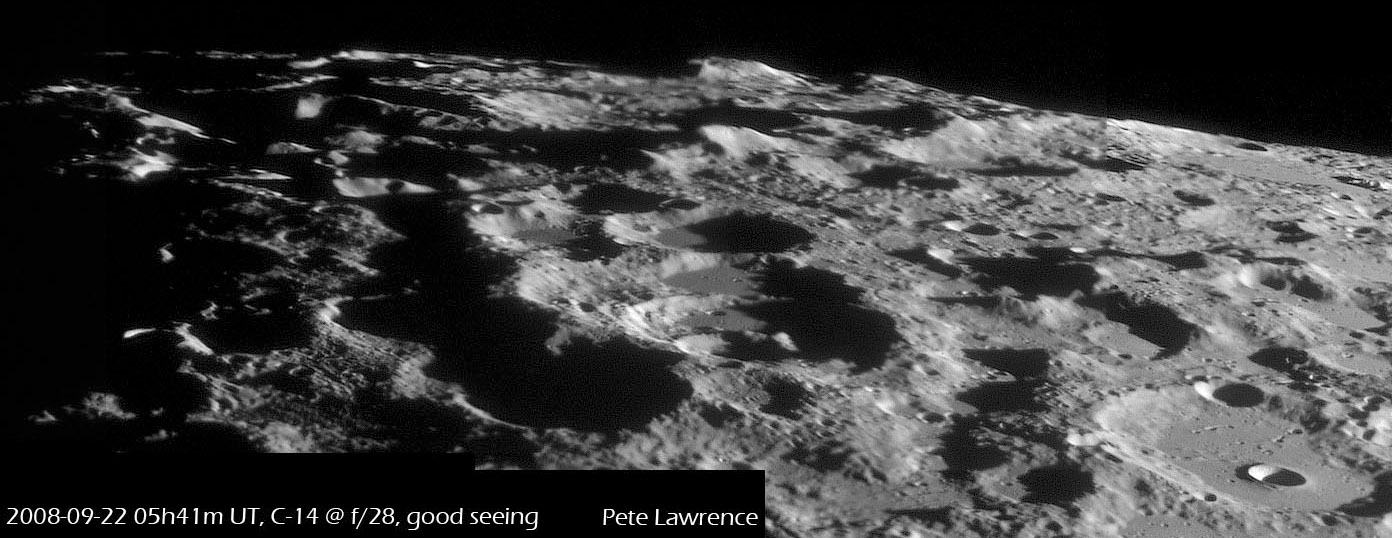Difference between revisions of "February 25, 2018"
| Line 7: | Line 7: | ||
<em>image by [mailto:digital.astronomy@gmail.com Pete Lawrence]; south up</em><br /> | <em>image by [mailto:digital.astronomy@gmail.com Pete Lawrence]; south up</em><br /> | ||
<br /> | <br /> | ||
| − | The south polar region is the most dramatic place to observe on the Moon. There are always shadows nearby, highlighting deep craters and tall mountains. As I marveled at Pete's recent view I noticed the triple or quadruple crater cluster near the center front that includes Newton. It is amazing that such a towering figure of science and astronomy would have received such a hard to see crater. Was the name given by an angry rival or someone who disbelieved in universal gravitation or an ex-student who failed calculus? The way to tell is to check [https://the-moon.us/wiki/Newton Newton] in [https://the-moon.us/wiki/Introduction The Moon Wiki]. The name was given by Schröter to a ghost crater south of Plato, but was moved by the great 19th century selenographer [https://the-moon.us/wiki/ | + | The south polar region is the most dramatic place to observe on the Moon. There are always shadows nearby, highlighting deep craters and tall mountains. As I marveled at Pete's recent view I noticed the triple or quadruple crater cluster near the center front that includes Newton. It is amazing that such a towering figure of science and astronomy would have received such a hard to see crater. Was the name given by an angry rival or someone who disbelieved in universal gravitation or an ex-student who failed calculus? The way to tell is to check [https://the-moon.us/wiki/Newton Newton] in [https://the-moon.us/wiki/Introduction The Moon Wiki]. The name was given by Schröter to a ghost crater south of Plato, but was moved by the great 19th century selenographer [https://the-moon.us/wiki/Beer_and_Madler Mädler] to its present polar wilderness. I am surpized that Schröter and Mädler couldn't find a better feature to memorialize perhaps the greatest scientist ever. Was it because he was English and they were German (there was a lot of rivalry then)? That seems too petty, but between them Schröter and Mädler gave hundreds of new names - surely they could have done better for Isaac Newton?<br /> |
<br /> | <br /> | ||
<em>[mailto:tychocrater@yahoo.com Chuck Wood]</em><br /> | <em>[mailto:tychocrater@yahoo.com Chuck Wood]</em><br /> | ||
Latest revision as of 17:46, 13 October 2018
What's in a Name?
Originally published September 23, 2008

image by Pete Lawrence; south up
The south polar region is the most dramatic place to observe on the Moon. There are always shadows nearby, highlighting deep craters and tall mountains. As I marveled at Pete's recent view I noticed the triple or quadruple crater cluster near the center front that includes Newton. It is amazing that such a towering figure of science and astronomy would have received such a hard to see crater. Was the name given by an angry rival or someone who disbelieved in universal gravitation or an ex-student who failed calculus? The way to tell is to check Newton in The Moon Wiki. The name was given by Schröter to a ghost crater south of Plato, but was moved by the great 19th century selenographer Mädler to its present polar wilderness. I am surpized that Schröter and Mädler couldn't find a better feature to memorialize perhaps the greatest scientist ever. Was it because he was English and they were German (there was a lot of rivalry then)? That seems too petty, but between them Schröter and Mädler gave hundreds of new names - surely they could have done better for Isaac Newton?
Chuck Wood
Technical Details
see image
Related Links
Rükl plate 73
Yesterday's LPOD: A Celestron Orange Moon
Tomorrow's LPOD: Edging Along the Limb
COMMENTS?
Register, Log in, and join in the comments.



